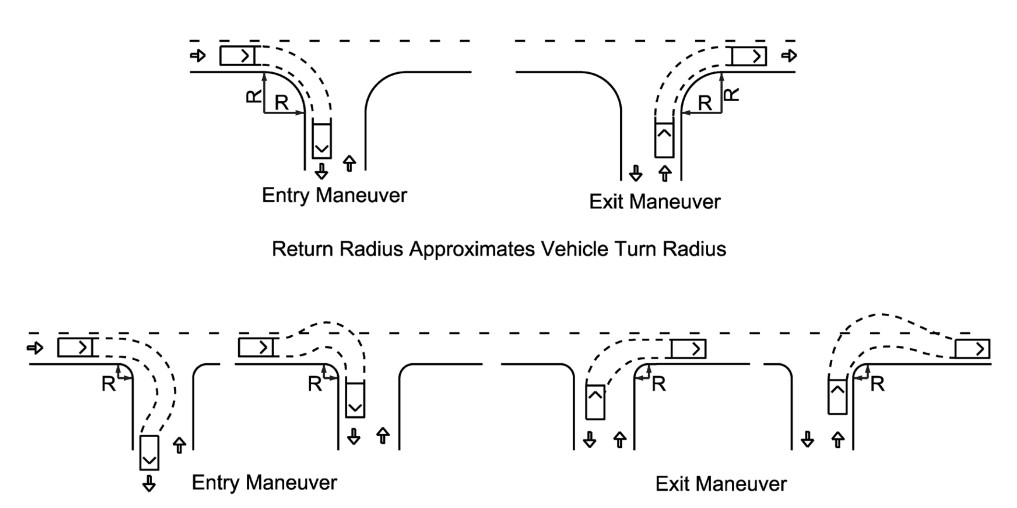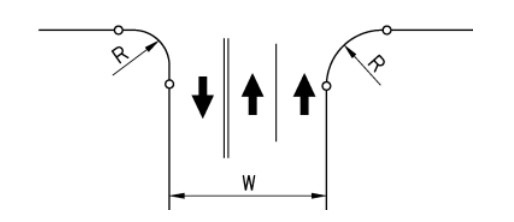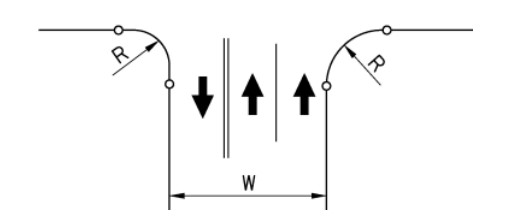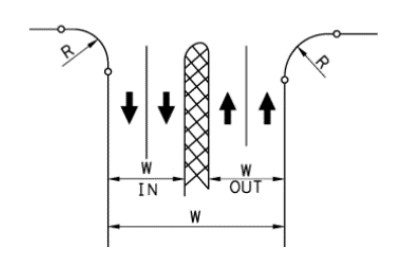16.2 General Design Guidelines
The following guidelines apply to all driveways on a State Highway.
illustrates the driveway design elements including return radius, entry width, exit width, throat width, and throat length.
- The driveway placement should be such that drivers approaching from the main roadway will have sufficient sight distance to ascertain the driveway’s location to safely decelerate and complete the entry maneuver. Also, the driveway placement should be such that an exiting driver will have sufficient sight distance to judge a safe gap in oncoming traffic. See for sight distance factors to be taken into consideration.
- For selecting appropriate driveway spacing distance or to determine if anacceleration or deceleration laneis warranted, refer to TxDOT’s . When acceleration or deceleration lanes are provided, see for proper lengths, and recommended applications.
- Each driveway should accommodate the effective turning radius of the appropriate design vehicle. The appropriate design vehicle will generally be the passenger car (AASHTO P design vehicle) unless the driveway will routinely be expected to handle more than four larger vehicles per hour. Examples of facilities for which a larger design vehicle would normally be appropriate include truck terminals, bus terminals, and connections that serve the loading docks of shopping centers. illustrates the effects of the radius on the right-turn entry and exit maneuver.
- A Flared Taper Return is easier to construct than a Radial Return but is less effective in terms of conforming to the turning path of a vehicle. The use of a Flared Taper Type Return should generally be limited to low volume driveways. When a curb and gutter Radial Return or Flared Taper Return encroaches on a pedestrian facility, a curb return consistent with must be provided.
- With the exception of private residential driveways, farm/ranch driveways, field driveways, and driveways that are designed and signed for one-way operation (i.e., ingress or egress only but not both), driveways should be designed to accommodate simultaneous entry and exit by the appropriate design vehicle.
- Where a driveway is expected to cross a pedestrian or bicycle facility now or in the future, special design requirements may apply. See , , and for more information.
- It is prohibited for private property owners to place markings or signs (such as Stop Signs, Entry or Exit signs) near driveways within the state ROW.
- Throat length is a part of the overall design and functioning of a driveway considering driveway geometry, frontage road and driveway traffic volumes over time, traffic patterns and movements, vehicle types, and property site layout.

Figure 16-1: Driveway Design Elements

Figure 16-2: Effects of Return Radius on the Right-Turn Maneuver
16.2.1 Geometrics for Two-Way Driveways
The following are standards for two-way driveways. See
through
for examples of two-way driveways.
- Private Residential Driveway - normally designed as non-simultaneous two-way driveways. Standard design criteria for private residential driveways are provided in . If the throat width does not match the existing driveway at the ROW line and additional ROW is required, then match the existing driveway throat width to avoid unnecessary ROW acquisition to meet minimum throat width requirements. If additional length of driveway is needed, then an easement or similar should be obtained to connect to the driveway outside of TxDOT ROW.
Radius 1 (ft) | Throat Width | |
Standard (ft) | Maximum (ft) | |
15 | 14 | 24 |
Notes: | ||
1. Urban roadways with limited distance from the road ROW line may use lesser radii that fit within the state ROW. Some residential driveways may have wider throats due to unusual site conditions. | ||
- Commercial Driveways- should be based on the appropriate design vehicle. Properties served by such driveways include, but are not limited to, truck stops, warehouses, concrete batch plants, sources of aggregate, RV sales/truck sales and RV parks. The design should also consider future roadway traffic and local conditions and incorporate simultaneous two-way driveways if justified.
- Two exit lanes are recommended when the expected driveway exit volume exceeds 200 vph.
- In cases where one-way operation is appropriate, a condition of the driveway permit should require that appropriate one-way signing be installed and maintained.
provides standard design criteria for two-way commercial driveways that would be expected to accommodate only P and SU design vehicles. Driveway designs for larger vehicles will be considered on a case-by-case basis.
- Service Driveways- service driveways should be designed considering the vehicle type and frequency of use, current and future traffic operations on the State Highway, and other local conditions.
- Field Driveways- the distance from the edge of the shoulder to a gate should be sufficient to accommodate the longest vehicle (or combination of vehicles such as a truck and trailer) expected. At a minimum, this will normally be a truck with trailer.
- Farm/Ranch Driveway- a typical design for a farm/ranch driveway should provide 25-ft return radii and a 20-ft throat width. The distance from the edge of pavement must be sufficient to store the longest vehicle, or combination of vehicles, expected. At a minimum, this will normally be a truck with trailer.
On existing roadway reconstruction projects, driveways may be reconstructed at the same width and location. However, all driveways being considered for reconstruction should be re-evaluated to determine if more appropriate widths, locations, or driveway deletions or changes will provide additional traffic safety and functionality. The potential impacts to the whole adjacent property due to a material change of access should also be considered. Refer to TxDOT’s
for additional information.
Condition | Radius (R) (ft) (Min.) | Throat Width (W) (ft) |
Notes: | ||
1. See Table 16-3 for minimum divider widths. 2. See Table 16-3 for maximum divider widths. 3. Driveway designs for larger vehicles will be considered on a case-by-case basis | ||

Figure 16-3: One Entry Lane/One Exit Lane

Figure 16-4: One Entry Lane/Two Exit Lane (Without a Divider)

Figure 16-5: One Entry Lane/Two Exit Lanes (With a Divider)

Figure 16-6: Two Entry Lanes/Two Exit Lanes (With a Divider)
16.2.2 Geometrics for Divided Driveways
A raised or depressed separation between the entry and exit sides of a divided driveway needs to be visible to drivers. Suggested treatments and divider sizes are shown in
.
Treatment | Width 3 | Length |
Slightly raised 1 (4-in) with contrasting surface | 4 2 –15 | 20 |
Notes: | ||
1. For Rural - Rounded edges, 30° to 45° slope. (See Figure 16-7). 2. 6-ft minimum for pedestrian refuge, measured from back of curb (desirable) or from nominal face of curb (minimum). 3. Measured from nominal face of curb. | ||
illustrates a slightly raised divider (height ≥ 4 inches).

Figure 16-7: Illustration of Slightly Raised Divider
A divided driveway is desirable in the following situations:
- There is a total of four or more entering and exiting lanes; or
- A large number of pedestrians (30 or more in a one-hour interval) routinely cross the driveway.
Locating appropriate signing (refer to the
) and lighting within a divider may assist approaching drivers in determining the driveway’s location and geometrics.
An excessively wide divider may confuse drivers and cause them to think there are two closely spaced, two-way driveways. To avoid this problem, the
recommended maximum width of a divider is 15-ft
. On the other hand, a divider that is too narrow may not be adequately visible to the motorist. Therefore, the recommended minimum width of a slightly raised divider (height ≥ 4-in) is 4-ft and 6-ft for a Pedestrian Refuge.
16.2.3 Bicycle and Pedestrian Considerations
Where a driveway is expected to cross a bicycle or pedestrian facility now or in the future, special design requirements may apply. Driveway crossings should be designed so that pedestrians, cyclists, and drivers are able to negotiate the driveway crossing efficiently and safely. Desirably, the passable portion of the driveway should be delineated within the limits of the driveway (e.g., construction joints or visual contrast across the driveway). See
and
for more information.